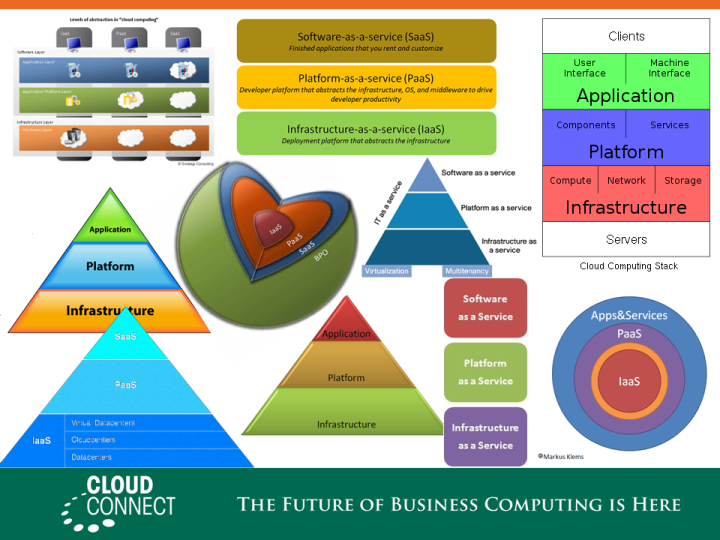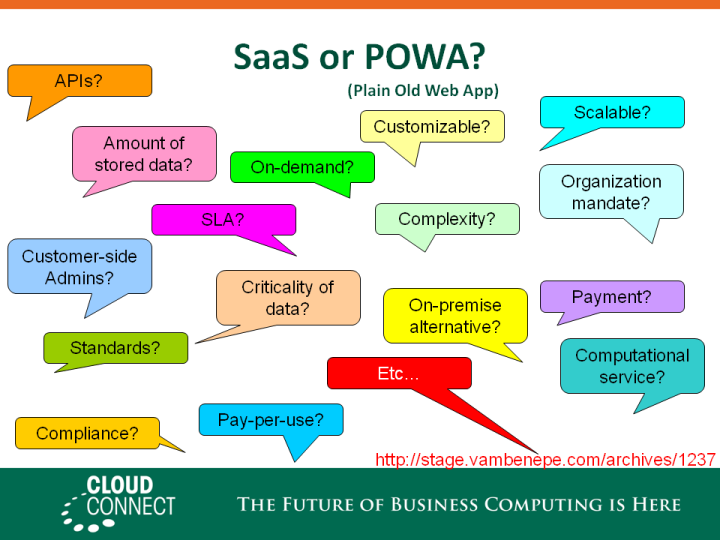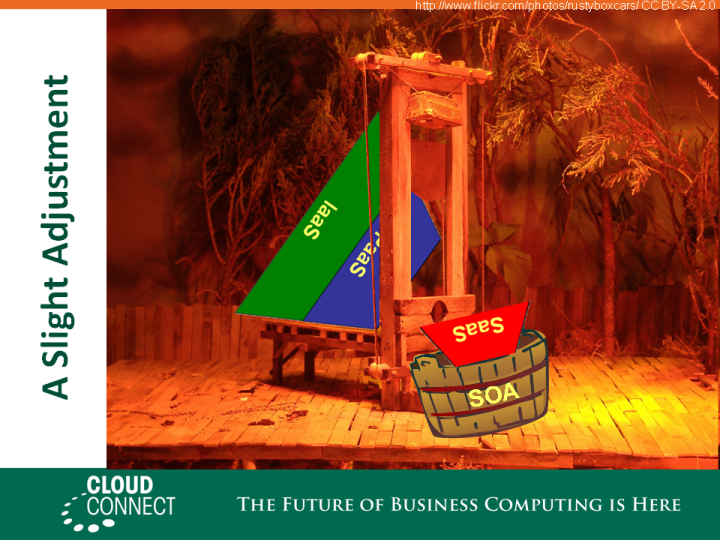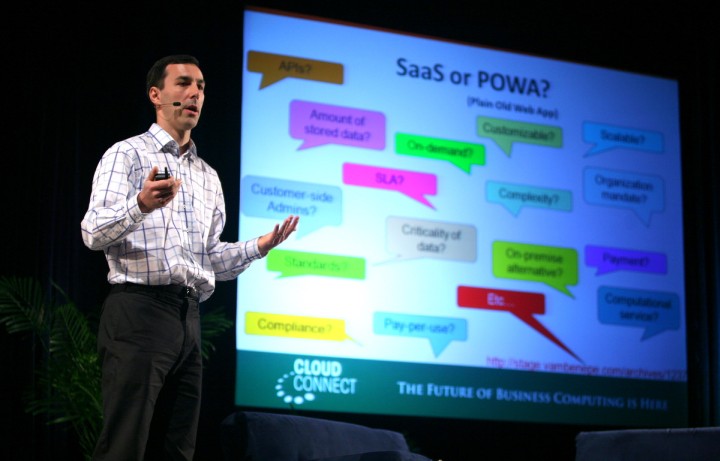The battle of the Cloud Frameworks has started, and it will look a lot like the battle of the Application Servers which played out over the last decade and a half. Cloud Frameworks (which manage IT automation and runtime outsourcing) are to the Programmable Datacenter what Application Servers are to the individual IT server. In the longer term, these battlefronts may merge, but for now we’ve been transported back in time, to the early days of Web programming. The underlying dynamic is the same. It starts with a disruptive IT event (part new technology, part new mindset). 15 years ago the disruptive event was the Web. Today it’s Cloud Computing.
Stage 1
It always starts with very simple use cases. For the Web, in the mid-nineties, the basic use case was “how do I return HTML that is generated by a script as opposed to a static file”. For Cloud Computing today, it is “how do I programmatically create, launch and stop servers as opposed to having to physically install them”.
In that sense, the IaaS APIs of today are the equivalent of the Common Gateway Interface (CGI) circa 1993/1994. Like the EC2 API and its brethren, CGI was not optimized, not polished, but it met the basic use cases and allowed many developers to write their first Web apps (which we just called “CGI scripts” at the time).
Stage 2
But the limitations became soon apparent. In the CGI case, it had to do with performance (the cost of the “one process per request” approach). Plus, the business potential was becoming clearer and attracted a different breed of contenders than just academic and research institutions. So we got NSAPI, ISAPI, FastCGI, Apache Modules, JServ, ZDAC…
We haven’t reached that stage for Cloud yet. That will be when the IaaS APIs start to support events, enumerations, queries, federated identity etc…
Stage 3
Stage 2 looked like the real deal, when we were in it, but little did we know that we were still just nibbling on the hors d’oeuvres. And it was short-lived. People quickly decided that they wanted more than a way to handle HTTP requests. If the Web was going to be central to most programs, then all aspects of programming had to fit well in the context of the Web. We didn’t want Web servers anymore, we wanted application servers (re-purposing a term that had been used for client-server). It needed more features, covering data access, encapsulation, UI frameworks, integration, sessions. It also needed to meet non-functional requirements: availability, scalability (hello clustering), management, identity…
That turned into the battle between the various Java application servers as well as between Java and Microsoft (with .Net coming along), along with other technology stacks. That’s where things got really interesting too, because we explored different ways to attack the problem. People could still program at the HTTP request level. They could use MVC framework, ColdFusion/ASP/JSP/PHP-style markup-driven applications, or portals and other higher-level modular authoring frameworks. They got access to adapters, message buses, process flows and other asynchronous mechanisms. It became clear that there was not just one way to write Web applications. And the discovery is still going on, as illustrated by the later emergence of Ruby on Rails and similar frameworks.
Stage 4
Stage 3 is not over for Web applications, but stage 4 is already there, as illustrated by the fact that some of the gurus of stage 3 have jumped to stage 4. It’s when the Web is everywhere. Clients are everywhere and so are servers for that matter. The distinction blurs. We’re just starting to figure out the applications that will define this stage, and the frameworks that will best support them. The game is far from over.
So what does it mean for Cloud Frameworks?
If, like me, you think that the development of Cloud Frameworks will follow a path similar to that of Application Servers, then the quick retrospective above can be used as a (imperfect) crystal ball. I don’t pretend to be a Middleware historian or that these four stages are the most accurate representation, but I think they are a reasonable perspective. And they hold some lessons for Cloud Frameworks.
It’s early
We are at stage 1. I’ll admit that my decision to separate stages 1 and 2 is debatable and mainly serves to illustrate how early in the process we are with Cloud frameworks. Current IaaS APIs (and the toolkits that support them) are the equivalent of CGI (and the early httpd), something that’s still around (Google App Engine emulates CGI in its Python incarnation) but almost no-one programs to directly anymore. It’s raw, it’s clunky, it’s primitive. But it was a needed starting point that launched the whole field of Web development. Just like IaaS APIs like EC2 have launched the field Cloud Computing.
Cloud Frameworks will need to go through the equivalent of all the other stages. First, the IaaS APIs will get more optimized and capable (stage 2). Then, at stage 3, we will focus on higher-level, more productive abstraction layers (generally referred to as PaaS) at which point we should expect a thousand different approaches to bloom, and several of them to survive. I will not hazard a guess as to what stage 4 will look like (here is my guess for stage 3, in two parts).
No need to rush standards
One benefit of this retrospective is to highlight the tragedy of Cloud standards compared to Web development standards. Wouldn’t we be better off today if the development leads of AWS and a couple of other Cloud providers had been openly cooperating in a Cloud equivalent of the www-talk mailing list of yore? Out of it came a rough agreement on HTML and CGI that allowed developers to write basic Web applications in a reasonably portable way. If the same informal collaboration had taken place for IaaS APIs, we’d have a simple de-facto consensus that would support the low-hanging fruits of basic IaaS. It would allow Cloud developers to support the simplest use cases, and relieve the self-defeating pressure to standardize too early. Standards played a huge role in the development of Application Servers (especially of the Java kind), but that really took place as part of stage 3. In the absence of an equivalent to CGI in the Cloud world, we are at risk of rushing the standardization without the benefit of the experimentation and lessons that come in stage 3.
I am not trying to sugar-coat the history of Web standards. The HTML saga is nothing to be inspired by. But there was an original effort to build consensus that wasn’t even attempted with Cloud APIs. I like the staged process of a rough consensus that covers the basic use cases, followed by experimentation and proprietary specifications and later a more formal standardization effort. If we skip the rough consensus stage, as we did with Cloud, we end up rushing to do final step (to the tune of “customers demand Cloud standards”) even though all we need for now is an interoperable way to meet the basic use cases.
Winners and losers
Whoever you think of as the current leaders of the Application Server battle (hint: I work for one), they were not the obvious leaders of stages 1 and 2. So don’t be in too much of a hurry to crown the Cloud Framework kings. Those you think of today may turn out to be the Netscapes of that battle.
New roles
It’s not just new technology. The development of Cloud Frameworks will shape the roles of the people involved. We used to have designers who thought their job was done when they produced a picture or at best a FrameMaker or QuarkXPress document, which is what they were used to. We had “webmasters” who thought they were set for life with their new Apache skills, then quickly had to evolve or make way, a lesson for IaaS gurus of today. Under terms like “DevOps” new roles are created and existing roles are transformed. Nobody yet knows what will stick. But if I was an EC2 guru today I’d make sure to not get stuck providing just that. Don’t wait for other domains of Cloud expertise to be in higher demand than your current IaaS area, as by then you’ll be too late.
It’s the stack
There aren’t many companies out there making a living selling a stand-alone Web server. Even Zeus, who has a nice one, seems to be downplaying it on its site compared to its application delivery products. The combined pressure of commoditization (hello Apache) and of the demand for a full stack has made it pretty hard to sell just a Web server.
Similarly, it’s going to be hard to stay in business selling just portions of a Cloud Framework. For example, just provisioning, just monitoring, just IaaS-level features, etc. That’s well-understood and it’s fueling a lot of the acquisitions (e.g. VMWare’s purchase of SpringSource which in turn recently purchased RabbitMQ) and partnerships (e.g. recently between Eucalyptus and GroundWork though rarely do such “partnerships” rise to the level of integration of a real framework).
It’s not even clear what the right scope for a Cloud Framework is. What makes a full stack and what is beyond it? Is it just software to manage a private Cloud environment and/or deployments into public Clouds? Does the framework also include the actual public Cloud service? Does it include hardware in some sort of “private Cloud in a box”, of the kind that this recent Dell/Ubuntu announcement seems to be inching towards?
Integration
If indeed we can go by the history of Application Server to predict the future of Cloud Frameworks, then we’ll have a few stacks (with different levels of completeness, standardized or proprietary). This is what happened for Web development (the JEE stack, the .Net stack, a more loosely-defined alternative stack which is mostly open-source, niche stacks like the backend offered by Adobe for Flash apps, etc) and at some point the effort moved from focusing on standardizing the different application environment technology alternatives (e.g. J2EE) towards standardizing how the different platforms can interoperate (e.g. WS-*). I expect the same thing for Cloud Frameworks, especially as they grow out of stages 1 and 2 and embrace what we call today PaaS. At which point the two battlefields (Application Servers and Cloud Frameworks) will merge. And when this happens, I just can’t picture how one stack/framework will suffice for all. So we’ll have to define meaningful integration between them and make them work.
If you’re a spectator, grab plenty of popcorn. If you’re a soldier in this battle, get ready for a long campaign.




